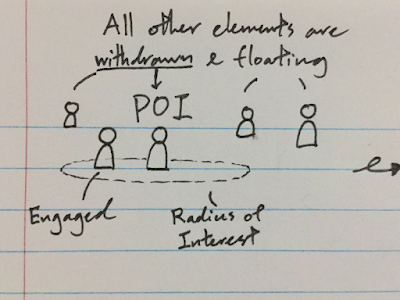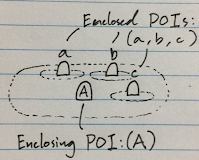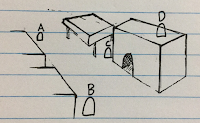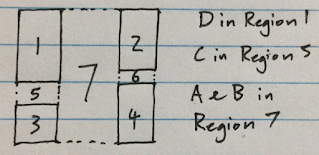This is an old revision of the document!
About My Start in TTRPG
Hello everyone, I am DumplingIsNice. I am a Hobbit who had been stuck in his cave.
My TTRPG journey began with my high school Anime & Manga afternoon club. The seniors of the club organised an activity of some sort – we make up a character to roleplay in a fictional world. “Like acting out your own anime-like story” the friendly senior said. Instead of a dungeoneering party of adventures, we were a classroom of students attending an academy. And true to the spirit of the “academy stories” of Japanese anime culture, our characters would get into shenanigans, fight monsters and students alike in torment style arcs. Looking back, the game system was probably something made up by the club leader and we were his little play testers. There isn’t much I could remember now save for a piece of rugged, stained and teared up character sheet archived in a folder.
As a junior, roleplaying with seniors who racked sick beards, who drops lewd jokes as we roleplay as our made-up characters in an anime-esc setting was a time I looked forward to dearly every week. Those youthful afternoons were a piece of cherished memory impressed deeply in my first contact with TTRPG. In fact, my very internet avatar I use till this day was the portrait I drew for my very first TTRPG character.
Then comes the years when I was a high school senior, two years before graduation. The club have long ceased their activities in TTRPG since the previous leader left. Out of the blue, in our graphic modelling class, one of my mates asked: “Hey – Wanna try playing DND?”… I immediately purchased the latest starter set of DND 5e, “The Lost Mines of Phandalin” and off we go. This was the first time I acted as a GM, and the game crashed and burned rather quickly. I was lucky to have friends willing to give me second chances, and successfully ran my second campaign under 5e with our own writings of scenarios, dungeons and story. From then on, my times spent with TTRPGs only increased.
After graduation, I had a friend who kept our shared passion for TTRPG long after we have scattered to the four winds. We would meet up regularly and contemplate on the very amazing thing that is TTRPG. We would bounce ideas off of each other, write our own systems and jump up and down in the kitchen off of our hypes. And through some curious development, discussing philosophy of TTRPG and TTRPG design. Despite DND 5e’s dormant and emergent popularity at the time, we deeply loathed the game system. Like a bunch of TTRPG hippies (reject mainstream, return to origin) we delve headfirst into any TTRPG system that isn’t DND or Pathfinder.
On my end, I confess my content denial of an Anime junkie. And naturally I came to discover properly published Japanese TTRPG (JTTRPG). Through the aid of helpful compatriots of the internet I was able to access many JTTRPG material despite being a weeb who know nothing of Japanese. Yet the culture of JTTRPG fascinates me, deriving similar origins (in DND 3.5, CoC etc.) but developed in a different direction. Whilst heavily influences by Anime and video game culture, it was an interesting tie to their relevant media in the thematic of game systems. The impact is still felt today as I occasionally revisit it.
It was from the Black Hack that I entered the OSR scene, or technically, it was the first time I realized that OSR existed. Before, I simply had the recognition that OSR is synonymous to old-school DND – people playing older editions of DND. Oh boy.
Now, I ended up indulging myself in the OSR scene. Years of content accumulated through history, an unspeakable trove of blogs yet to be discovered. The blogsphere alone was like an ancient dungeon, with each post linking each other like a net of passageways. Sometimes, miraculously completing a loop back to the blog I started in. The treasures of wisdom I found from my predecessors in this hobby was something I regretted to not have discovered sooner.
Now, the other thing I regretted was not starting my own blog sooner. All of the ideas I discussed with my best friend in the kitchen were shamefully lost to the grindstone of time. Now I deem to document our ideas we discuss today, to emerge from our labs and ready to face the debilitating criticisms that comes with the internet. But more so, to challenge our thinking process by putting our ideas to words and leave a record we may compare ourselves to years later.
At this point, this game system is a weird mix between OSR, Japanese TTRPG and my own feverish concoction of homemade rulings.
An Abstract Coordinate System for Theatre of the Mind
Aim: To document the concept of the Point of Interest methodology.
What is a Point of Interest?
A Point of Interest (POI), attention and/or focus is an area of attentiveness and activity that is worthy of concern. Such concerns are to observe, interact, (re)construct or change.
Points where interesting things happen, to whom we concern.
Any framable element/aspect that is relevant to the immediate narrative may be identified as a POI. The POI is a focus zone where stimulus gathers and will gather in the future. Typically, the POI is where the attention is drawn to in the immediate narrative. While A POI is typically an object, the point of interest may lens in on any narrative elements:
- Object, location, landmark, prop.
- Person, character, actor.
- Sight, spoken word, sound, smell - Senses.
- Abstract concepts, ideas, thoughts.
Thus, when describing a POI, only the elements that are of relevance and/or relative importance are mentioned. Redundant information is implicitly acknowledged but ignored in consideration.
I.e. POI on a thief running through the streets will only shed a spotlight on the thief and the immediate surroundings of the thief. Additional information regarding the streets, the buildings and people are implicitly acknowledged but ignored until a POI is focused around them.
Rule of Thumb:
- If everything happening right now in the story revolves around a number of keystone elements, these elements are each in of themselves a POI.
- If a thing, event or aspect is recognizable (right now), worthy of attention and will remain attentive as long as it's on stage, it is a POI.
Note: POIs are not inflexible classifications, unless necessary, do not explicitly identify POIs or the Radius of Interest ROI.
Anecdote: POI Analogies
In a stageplay, the POI can be recognized as the “anchor” or a “spotlight” on something. Then, all other elements on-stage will be remembered as peripherals “revolving” around the POI. If there is more than one POI, components will exhibit behaviour similar to planetary orbits.
The purpose of a POI is to act as an anchor for the current narrative elements to revolve around. Hence, there should never be more than a handful of POI that is recognizable in the player’s conscious domain. An abundance of POI will invalidate this purpose.
An Example POI Spatial Scale System
This is an example of the implementation of a spatial scale system for a TTRPG formal system using the ideas of POI. This example is created to accompany the ideas from the Fantasia TTRPG Gameplay Structure (to be discussed at an alternate date).
For gameplay, the concepts behind POI may be adapted as a spatial scale for a formal system. Such spatial scale systems are designed to highlight focus and attention.
A POI is an anchor used to reference other gameplay elements with respect to it. A shared understanding of the POI at play will:
- Promotes a sense of unity and consistency among players.
- Helps align the tellings of common canons by identifying the most important elements.
- Easy to recognize artefacts in the theatre of the mind.
- Easy to vocally make reference to.
Idea: Radius of Interest (ROI)
A POI’s radius of interest is an abstract region around a POI, to whom the POI concerned. All elements inside this radii are in some form relevant and in immediate reach of interaction with the POI. There must not be any precise length of this radius, only descriptors of the radius’s extent/influence.
Examples:
A brawler in a fight will have a radius of interest as far as arm’s length, if not greater, as per a region where his indomitable combat prowess may extend to. This is similar to the trope of swordsman's zones. Where they tacitly understand the region and what they’ll be cut down once enter.
For the purpose of overland travel and wildlife mapping, beasts who wander in the Overview Level of Perception will have a radius of interest as far as their territory. When they are encountered, the ferocious domain a beast may pounce in, chase and bite in is its radius of interest in the Tunnel View Level of perception.
A plague raging through a town will have a radius as far as the pathogen reaches.
The best analogy for the radius of interest is that of a cloud. It is a vaguely defined region of influence. Akin to an electron cloud.
Engagement with a POI
For any element, its status with respect to a POI may be described as:
- [Engaged] - An element is said to be “engaged with a POI '' when it is inside a POI’s radius of interest. This state of being can be interpreted as if the element exists simultaneously everywhere in the POI but nowhere else. The element becomes explicitly acknowledged as if it is in the spotlight.
- Typically interpreted as: Melee Range.
- [Withdrawn] - An element is said to be “withdrawn from a POI” when it is outside a POI’s radius of interest.
- Typically interpreted as: Ranged Range.
- [Floating] - An element is said to be “floating” when it is not engaged with any POI. This state of being can be interpreted as if the element exists simultaneously everywhere else but any POI. The element becomes implicitly acknowledged as if the element is on the brink of being ill concerned/forgotten by the current scene.
When an element leaves the [Floating] status, it also effectively leaves the scene.
Some Ruling Clarification
This is explained explicitly here.
- A POI [Engaged] with another POI must mean both POI are [Engaged] with each other. Regardless of the extent of either POI’s radius of interest.
- When an [Floating] element engages an existing POI, it becomes [Engaged] with that POI.
- When an [Floating] element is engaged, that element becomes a POI.
- A [Floating] element must also be [Withdrawn] from any POI.
- An element [Engaged] with a POI will be [Withdrawn] from another given POI.
- Unless both POI is already [Engaged] with each other.
To re-engage an [Floating] element, a teller simply needs to re-introduce the element to the narration:
- Mention or make reference.
- Interact and engage.
- Allow the element to re-engage due to the element’s agency or the world’s (GM’s).

Establishing a POI
POI may be identified and established:
- During the framing of the scene as the stage is decorated.
- Immediately before a tension-filled, high stake event occurs.
Either way, the details in interaction using the spatial scale are only applicable during action under tension with stakes on the line. Otherwise, treat a POI as would any other narrative element.
It is worthy of note that an important, foci narrative element does not need to be identified as a POI. Identify narrative elements as POI as they are required.

Cascaded POI
Multiple POI may cascade into one another. Remember to treat each POI as what they are: a narrative element.
If an element is:
- [Engaged] with a, b or c, it is also [Engaged] with A.
- [Engaged] with A, it is not necessarily engaged with a, b or c.
Chases
A chase under the POI spatial scale system is a competition in status. The escapee is the POI. The chaser desires to remain in the POI of the escapee. Whilst the escapee desires to leave the current scene.
The Scene Exiting Method:
- [Exiting] - A element is said to be [Exiting] when they are in the process of leaving the current scene. An element gains this status when they express the desire to exit the current scene.
- [Entering] - A element is said to be [Entering] when they are in the process of entering the current scene. An element gains this status when they express the desire to exit the current scene.
While in the state of [Floating], you may choose to move and begin escaping. You are [Exiting] the scene. On your next acting order, if you are still [Exiting], you may choose to leave the scene.
To chase an [Exiting] escapee, you may choose to move and begin some interaction to stop the [Exiting] process with the escapee as described by the formal system you are using.
- On success, you are [Engaged] with the escapee.
- On failure, you are now [Withdrawn] from the POI you originally were in.
Escapees who have already left the scene can no longer be pursued within the current scene. The chaser must reignite their pursuit in an alternative scene. To do so, the chaser needs to exit the scene themselves.
Advanced Utilisation of POI
The POI system fundamentally caters for information control and player agency manipulation.
Hidden Between the Lines (Tunnel Visioning)
Whether a POI is a POI worth attention is dependent on perspectives. The GM may hide information using POI.
When attention is no longer drawn, the element (character, space) loses its POI.
This character is outside of the immediate camera in an unknown circumstance to the PC.
For example, the thief transfers the chest to an accomplice. Without the knowledge of this, the thief will retain an “apparent” POI from the player’s perspective. Unless explicitly examined (ideally with a telegraphed clue), the thief will remain as the POI of the scene.
Using the properties of ignoring [Floating] elements as redundant information to the POI, the real POI is hidden. When the lie of the chest being bsent from the thief is discovered, the POI on the thief will be lost. When the thief loses that POI, they will become [Floating] unless otherwise engaged. Meanwhile, the POI shifts to this unknown accomplice who is somewhere in this town and effectively out of the scene.
This effect is effectively tunnel visioning.
Attention and Information Scope
Narration of plot time action only concerns the current source of attention, the POI’s. Any external, unaccounted for information (Such as environment details and floating elements) must be actively acquired by the character as it is merely on the rim of their attention. Furthermore ignored information will be excluded from the narration and effectively become hidden. If players fail to record, account or acknowledge the existence of ignored elements, those elements effectively become in [Floating] State.
For example, when the thief stole the chest from the merchant's hands, the POI is lost on the merchant and the thief gains the POI. The narration will focus on the thief at this point. The GM’s narration will no longer concern the merchant anymore as they are no longer the source of attention. Hence, no mention of the surroundings or the merchant’s reaction shall be mentioned until the PC chose to deliberately seek out that information. Therefore, the merchant is effectively hidden to the PC unless they choose to re-engage the merchant again.
Hitori: “I was just talking to the merchant, did the thief just take the chest under my eye? Can I stop it?”
GM: “Hitori, you were engaged with the merchant as the thief snatched the chest. You may intervene.”
*Hitori failed to intervene.
GM: “The POI is now on the thief. It withdrew from the merchant and disappeared into the crowd. You are withdrawn from the thief right now.”
Hitori: “Fucking after 'em!”
… In an alternate scene…
Tanin: “By the way, I wish to examine the merchant.”
GM: “Little did Hitori know, the merchant’s gasp twists into a grinch grin…”
Tanin: “Damn… This is some good kebab.”
Why do we Use Point of Interest?
A “theatre of the mind” approach in tracking positional information compromises a rigid formal system. It’s a lazy way of saying: “You can play miniature warfare in your head”. We can do better than reimaging miniature-based, wargaming gameplay on a grid in our heads. The wargaming form of thinking is rooted in sandboxes and the idea of absolute position. Instead of adapting an existing form of thinking, we can adopt a gameplay system designed precisely for “theatre of the minds”.
Contrasting with tessellated grid coordinate systems, POI is imprecise and abstract. To interpret a POI coordinate, a player requires active, imaginative thoughts to rationalize the coordinates’ relationship with the foci. However, the significant benefit POI has over grid coordinates is its commodity in shared recognition over the same coordinate despite the lack of precise information. Liberating some of the player’s limited cognitive resources and saving valuable session time otherwise spent recording the precise information.
In a grid coordinate system, participants' positions are mapped concerning grid cells as positions. While intuitive, manipulating the cells can be troublesome. The displacement between participants will fluctuate in dimension as the position changes, which needs to be reflected by updating the coordinates. Grid-based spatial scales take up cognitive resources in keeping and monitoring that information.
In a POI coordinate system, the position of participants is mapped with respect to a POI as the status. Let the escapee be the POI. The focal point is on the escapee, and only the escapee and its surrounding information are worthy of attention. If a chaser ever drops out of the radius of interest, it may be disregarded and reintroduced by a more straightforward method (checks). The exact pathways the participants traverse and the environment outside of the POI are irrelevant. Removing the need to monitor numerical information.
I.e. It is significantly more intuitive to identify the position of characters relative to a door when they are trying to go through rather than knowing the grid coordinate of characters in a room and the door at all times. If a need arises to include the door as a part of some tactical manoeuvre, simply do so without consulting the door’s absolution position.
Similarly, the POI space scale can be adapted as analogical artefacts at the table. The famous example from ICRPG uses the length of a banana as a rough distance. We may do the same:
- Miniatures: Physical representations of position. Remember to define clearly how distances are scaled.
- Pins and Strings: Using a pinboard, pin and tie representations together with strings to show they are connected to that POI.
- Rings: Rings representing radii overlapping.
Contrasting Grid, Zones and POI Spatial Systems
Example: Buildings and Streets
Grid
- Imagine an infinitesimal division of space.
- Position tracked by absolution positions.

 Zones
Zones
- Divide the stage into appropriate regions of significance.
 POI
POI
- Identifies focus.
- Ignores, yet implicitly acknowledges all other information.

QNA
Implicit rulings made clearer.
How should I even begin a battle knowing where every element is under the POI system?
Anything important to warrant attention or interest forms their own POI. If your “people” enter as a group, they form their own POI. For each individual “person”, they are [Floating]. For example:
Hitori and Tenin got into a bar fight with John and Kate. The reason they started the fight was because John insulted the Master. The bar is the current scene. The drinking bar where the master is at is a POI because he is involved. The door to the outside, any other partitions, tables, and the spit jar next to the column are all unrelated and thus do not warrant a POI; they may all be treated as [Floating]. Hitori and Tenin are good buddies, they together form a POI: “Hitori and Tenin”. Kate was good buddies with John, but she wishes to disassociate from him, Kate and John form a POI each, though more appropriately: John forms a POI, while Kate is [Floating].
Can I forcefully evict an element from a POI?
Yes, with an appropriate ruling, you may forcefully evict an element from a POI. Either that element becomes [Floating] or forms a POI by itself (or with you if, for example, you tackled someone out of a POI. If the element you evicted is the POI, then all other elements that were engaged with the POI now become [Withdrawn] from the POI.
What happens when a POI's foci are destroyed or perished?
The POI remains. If “John” was the POI and John died, “John’s corpse” is the new POI. Even if John disappears or gets sucked into the void, the POI and the elements that were engaged with John now engage each other and become a new POI: “Where John was”.
Can I prevent someone from entering/exiting a POI?
Sure, that depends on how your formal system handles the action with POI. For Example, entering and existing might require a check if an element is gatekeeping it, like a guard or an actual gate.
What other uses of POI besides tracking position in tension-filled environments (like a battle)?
Area of Effects (AOE), Mapping Locations, Inventory Organisation, Crafting Systems…
An element was a POI, and the other elements engaged with it disappeared. Is the element still a POI?
Depends. If the element is still necessary or exciting, it is a POI. If it is not, it can become [Floating]. Though it's worthy of note that even if the element remains a POI, the element is engaged with itself but AT THE SAME TIME, it is also [Floating]. Meaning that if the element were to wish to engage with another POI, it may do so without becoming [Floating] (as long as it is the lone element engaged with itself).
Can POIs overlap?
Yes, but I recommend keeping it to three POIs overlapping each other at max (like a Venn diagram). In this case, an element can be said to be engaged with two or more POIs at the same time. However, if A is engaged with B and C simultaneously, B and C must also be engaged with each other. If B and C were never engaged with each other, A cannot be simultaneously engaged with both B and C.

![Haut de page [T]](/lib/tpl/khum1//images/top.png)